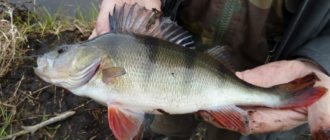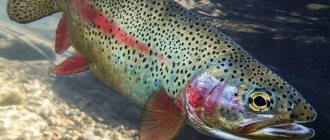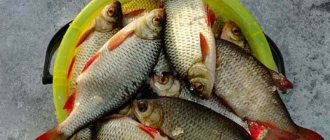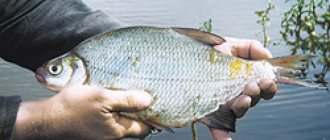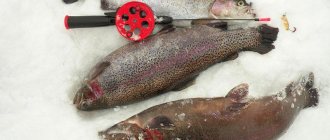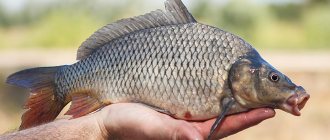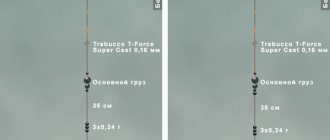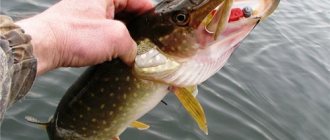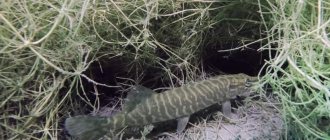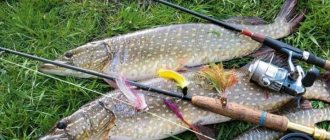White bream in winter, where to look. Effective fishing tactics. Tackle and tactics for catching silver bream in winter. Groundbait and groundbait.
The silver bream is a close relative of the bream, so to speak. But unlike its larger and more important silver-golden brother, the silver bream is not so scrupulous and capricious to weather changes and other metamorphoses (description of the silver bream). Therefore, due to its unpretentiousness, it often becomes a serious competitor to bream, or, rather, to bream, and successfully replaces it in catches when bream are capricious. Another positive feature of the winter silver bream for anglers is that they are not as careful about the thickness of the fishing line as the roach. It may stop biting when replacing the 0.08 to 0.12 mm fishing line. Even these tiny fractions of millimeters can cause a roach to completely reject the bait. In winter, silver bream can be caught normally using a fishing line 0.15 mm . In good weather and with stable pressure, silver bream is often excellently caught along with bream. And such fishing is often done at night in winter tents, which fishermen equip for completely comfortable fishing in the warmth and light.
Often, silver bream is caught with the simplest gear. This is what distinguishes the local residents, who quite successfully catch fat silver bream all winter. To do this, they stock up on dung and earthworms in the fall, keeping them in cellars, in wooden boxes, feeding them with boiled potatoes and soup. Knowledgeable local fishermen use worms to catch the largest silver bream. They do not like to drill many holes in search of a school of fish, and they have no time to engage in, as they say, self-indulgence. Therefore, in addition to fishing with nets, they practice fishing with bait . To do this, promising holes are made on the first ice, and throughout the winter bait is thrown into them, which can be the simplest and consists of various cereals and often with the addition of mixed feed.
Where to look for silver bream in winter and what to be wary of
White bream is a common fish species - it is found in river basins flowing into the Black, Azov, and Caspian Seas. You can meet it on large lakes and reservoirs, on rivers and reservoirs with stagnant water. The main thing is to find the habitat and the greatest activity of the flock. This is partly helped by bait, which can attract and hold fish, but it needs to be scattered at certain points, then winter fishing for silver bream will take place.
In winter, various pits are the most favorite natural shelter for this species. In such places, fish can stay at a depth of 3 meters and deeper, gathering in schools. Sometimes bream and roach can hide right there, which makes fishing more interesting. It would be good to fish the hole you find with bait. In the dead of winter, the silver bream will go into holes with springs located at the bottom; it is advisable to discover and remember these places in the summer, and return in winter with gear.
The largest individuals prefer places with reverse currents. A fisherman who can detect such a point will not be disappointed with his catch. The main rule is to be careful: in places with reverse flows, ice is often washed away.
Gustera does not like strong currents and tries to stay away from such places. But areas with weak currents are the most comfortable for fish. In winter, there are no problems with the supply of oxygen, so individuals are especially active, even in the dead of winter.
Experienced fishermen recommend checking points where several currents intersect. There won't always be a silver bream here, but there is such a possibility. The ice in this area is usually thin, so you should be careful and check its thickness with an ice pick.
On the Volga and some other rivers, winter fishing for silver bream is possible in coastal areas covered with reeds or reeds. In such places, individuals gather in small flocks of 10–15 pieces each, and greedily rush to the bait. You can catch fish in summer feeding areas, but only in thaws and at depths of 1–2 meters.
Best time for ice fishing for silver bream
The silver bream is one of the fish that is most active during daylight hours; there will be no catch at night. The bite is good in any weather; the fish are not affected by low temperatures and thaws, pressure changes and wind. However, anglers note that the greatest activity occurs on cloudy days; for some reason the silver bream does not like the bright sun.
The peak of the bite occurs in the first half of the day, when schools of fish begin to look for food and are most active. By lunchtime, having satisfied their hunger, the silver bream becomes lazier, which affects the bite. The nature of the behavior will also depend on the specific body of water, therefore it is impossible to name the exact time: fishermen calculate it empirically. Typically, on large rivers the peak of the silver bream bite occurs in the early morning, and on lakes it is closer to noon.
The best time to catch silver bream is in winter
In terms of biting activity, the silver bream has practically no equal. She bites throughout the daylight hours and only at night her bites stop. White bream is absolutely unpretentious to weather conditions; it continues to be caught in the dead of winter, when other fish completely stop biting, and during periods of thaw. This is one of the few fish that can be caught throughout the winter without worrying that it may not be active due to weather, pressure or other factors. Here it can only be compared with winter fishing for burbot, which becomes more active the stronger the frost.
Of course, on each body of water, the silver bream may be the most active at one time or another. You will have to calculate the peak activity of the silver bream on your pond yourself, but in any case, its bite will continue all day. The only thing that can cause the silver bream to lose activity is a lack of oxygen. Therefore, in reservoirs with low oxygen levels, reduced activity of the silver bream is observed.
Usually, the most active biting of the silver bream begins as soon as the reservoir is covered with ice and it has become strong enough to support the weight of the fisherman. But at this time you need to be very careful and always test the ice with a pick before taking the next step. Also, the activity of the silver bream intensifies with the approach of spring, and once you find a school of it, you can have incredibly active fishing with a rich catch.
Tackle for winter bream and ice fishing tactics
The bite of the silver bream is always extremely careful, so the best results are achieved by a fisherman armed with a winter fishing rod with a nod. The float does not allow you to show the desired reaction to a bite, therefore it is used much less often. There is no particular point in using anything else for fishing; a winter fishing rod is sufficient for catching silver bream from the ice.
Gear must meet the following requirements:
- The thickness of the line is in the range of 0.08 - 0.15 mm. Good results are achieved with a fishing line 0.12 mm thick.
- Sensitive nod.
- A jig with a small hook and a body of 2–3 mm.
If float tackle is used, the float should be as sensitive as possible.
Particular attention is paid to the jig. The silver bream has a small mouth, so the hooks must be small so that the fish can swallow them. You can use jigs of any type and color directly for fishing; some fishermen claim that an ant-shaped jig works great. For luring, it is better to take a drop-shaped jig of silver color.
On the Volga, blyamba is very popular, although some fishermen call it differently. This is a large jig in the shape of a cone and weighing 10–15 g. This choice is not accidental: the Volga and its tributaries have a fairly strong current, on which the jig behaves best. In skillful hands, the tackle rarely gets tangled and holds perfectly, which is not possible with other types of jigs. As bait, Volga fishermen use earthworms, mounted in the form of brushes. With such equipment you can even catch predators, but more often you come across silver bream, perch and pike perch, and at the end of winter, ide.
Sometimes Volga fishermen tie a leash 50–80 cm long with hooks No. 12–14 above the jig on the white bream. If necessary, they increase the thickness of the fishing line to 0.17 mm, which does not negatively affect the quality of the bite - on some days they catch up to 15 kg of large fish. This gear allows you to fish at a depth of up to 10 m in places with a current of medium strength. The weight of the sinker is selected individually: it needs to be slightly carried downstream. The fishing technique here is simple: the bait is cast downstream a little, then long pulls are made.
There are several ways to catch silver bream in winter using a jig. Fish can be found on different water horizons, including near the lower edge of the ice. Therefore, it is necessary to systematically change the fishing depth.
If the fish is on the bottom, you can swing the jig at a height of 5–10 cm from the ground, periodically letting it run along the bottom. In this way, it is possible to stir up the silt, which attracts a flock of silver bream. Another method involves using a slow retrieve to a height of about 30 cm, then lowering the jig to its original depth with a gentle rocking motion. This method will be effective if you can set the depth correctly.
In winter, silver bream can also be caught using a stationary jig. To do this, the following tactics are used:
- The fisherman carefully lowers the jig to the bottom.
- Slowly raises the jig to a height of 20 cm and always pauses for 3-5 seconds.
- After a pause, the jig goes back to the bottom, and at the moment it touches it, another pause is made.
Such movements attract the silver bream, which goes on the attack during the pause phase, and less often when the jig moves upward. The method is quite complicated: the attracted individual swallows the bait extremely carefully and this moment is difficult to notice if the attack occurred while the jig was moving upward. This means that the time for hooking will be difficult to notice, and without it you won’t be able to catch the fish. You have to be extremely careful, each time noting the vibration pattern of the fishing line. Only after catching several specimens in this way can you acquire the proper skill. In a situation where the attack on the bait occurs during a pause, such difficulties do not arise, the bite is very noticeable.
Another technique for ice fishing for silver bream in the current seems simple at first glance. The jig is lowered to the bottom, and then quickly raised to a height of about a meter. Having fixed it in this position for a few seconds, the jig is smoothly lowered to the bottom, making slight vibrations. Then the movements are repeated.
The silver bream is a timid and cautious fish; noise and drilling of holes scare it away. In clear weather, it can be scared away by many holes, so experienced fishermen look for secluded places, try to make a minimum of holes and maintain maximum silence.
How to make a summer fishing rod?
It is better to make summer tackle for silver bream light and not overweight it. The size of the fish does not imply any particularly stubborn struggle. But casting will have to be done further from the shore. Therefore, if you are choosing a float tackle, select a rod that is light and slender, up to 6 m long, equipped with a main line with a diameter of 0.20 - 0.25 mm, and a leash of 0.15-0.17 mm. Hooks are selected depending on the nozzle, No. 3.5-5.
Special requirements for the float - it must clearly convey the slightest manipulation of the fish with the nozzle.
A large float is not needed; it will make the tackle heavier and increase the number of idle hooks. The float is loaded with one sinker, which is located at least 15 cm from the nozzle so as not to scare the fish.
Bottom tackle should also not be rough. As a rule, ultra-long casts are not required; it is more important not to scare the fish in the fishing area. Therefore, a balanced rig with a small sinker, main line up to 0.30 mm, and leads 0.2-0.22 mm is selected. The bite alarm is configured in such a way as to make it possible to hook a fish at the first sign of a bite. It is interesting that when fishing on the current with bottom gear, the silver bream itself is often hooked well. In still water the situation is different and hooking is required at the first sign of a bite.
Groundbait and bait for winter silver bream
You can feed the silver bream with Salamis porridge, enriched with crushed earthworms or bloodworms, but it is better to use bream bait. Earthworms (experienced fishermen have been digging them since the fall) and bloodworms are well suited for bait. In winter, fishing works well with maggots, worms, as well as “sandwiches” - various combinations of these baits.
If you plan to fish with bloodworms, then you need to attach an odd number of them. For some reason, silver bream are especially careful if there is an even number of baits; they are more loyal to odd ones. This phenomenon cannot yet be explained.
The hooks must be completely hidden by the bait, especially the sting. The silver bream will never approach the bait if it looks suspicious: this fish is extremely careful and cunning.
What to catch silver bream in winter, the best baits
Well, there is nothing special with bait for winter fishing for silver bream, and you don’t need to invent anything. White bream is excellently caught using bloodworms, maggots, and dung worms. Sometimes a combined planting of maggots and bloodworms gives excellent results. When fishing with bloodworms, it is better to put several pieces of bloodworms on the jig, optimally 3.
When catching any fish in winter with bloodworms, it is always better to use an odd number of these larvae - 1, 3, 5... For some reason, the fish bite more actively when using this simple technique.
Be sure to ensure that the hook point is not visible. As mentioned above, the silver bream fish is very cautious and is afraid to approach the bait when it sees a bare hook.
The silver bream has a small mouth, so small jigs with a small hook are used to catch it.
It is best to use silver-colored jigs in the shape of a pellet or droplet for catching silver bream. And the “ant” jig is sometimes simply super catchy when fishing for silver bream. Although, if you find yourself on a flock of silver bream, then you will observe bites on any jig and their change will not show any noticeable changes.
White bream in winter on current and depth
In the dead of winter, the water is poorly saturated with oxygen, the situation is somewhat better only in areas with a current, and you need to look for them. Another option is to detect holes with underwater springs or places where streams or rivulets flow into a body of water (main river).
The bite of silver bream in the dead of winter is unimportant. The bite is noticeable only by subtle vibrations of the nod (feeling as if a bleak is biting). At this time, it is better to use a fishing line no thicker than 0.08 mm and a jig the size of a match head. If possible, the winter silver bream will go to a depth of 6 m, so use several jigs or use an additional leash with a No. 2.5 hook. This equipment allows you to fish at depth.
If the winter is warm this year, the school can be at a depth of up to 5–6 m, along with bream. At such times, it is good to use small maggots or burdock moth larvae as bait. This is one of the rare situations when a silver bream bites on a mothless fish in winter. It must be raised slowly, but rhythmically, to a height of about 1 m, then lowered to its original position. If bream lives in the same place, it will drive away other species, which must be taken into account when planning your fishing trip.
Hunting directly for silver bream is exciting, but it requires the fisherman to follow safety rules, perseverance and the ability to handle gear. If you successfully find a place, all your worries will pay off handsomely: in a day you can catch several tens of kilograms of fish.
